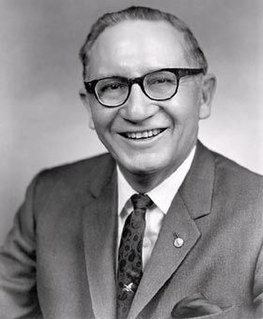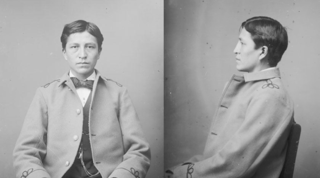The Lakota are a Native American people. Also known as the Teton Sioux, they are one of the three prominent subcultures of the Sioux people. Their current lands are in North and South Dakota. They speak Lakȟótiyapi—the Lakota language, the westernmost of three closely related languages that belong to the Siouan language family.

The Sioux or Oceti Sakowin are groups of Native American tribes and First Nations peoples in North America. The modern Sioux consist of two major divisions based on language divisions: the Dakota and Lakota; collectively they are known as the Očhéthi Šakówiŋ. The term "Sioux" is an exonym created from a French transcription of the Ojibwe term "Nadouessioux", and can refer to any ethnic group within the Great Sioux Nation or to any of the nation's many language dialects.

The Wounded Knee Massacre, also known as the Battle of Wounded Knee, was a massacre of nearly three hundred Lakota people by soldiers of the United States Army. It occurred on December 29, 1890, near Wounded Knee Creek on the Lakota Pine Ridge Indian Reservation in the U.S. state of South Dakota, following a botched attempt to disarm the Lakota camp. The previous day, a detachment of the U.S. 7th Cavalry Regiment commanded by Major Samuel M. Whitside approached Spotted Elk's band of Miniconjou Lakota and 38 Hunkpapa Lakota near Porcupine Butte and escorted them 5 miles (8.0 km) westward to Wounded Knee Creek, where they made camp. The remainder of the 7th Cavalry Regiment, led by Colonel James W. Forsyth, arrived and surrounded the encampment. The regiment was supported by a battery of four Hotchkiss mountain guns.

Red Cloud was one of the most important leaders of the Oglala Lakota from 1868 to 1909. He was one of the most capable Native American opponents whom the United States Army faced in its invasion of the western territories. He defeated the United States during Red Cloud's War, which was a fight over control of the Powder River Country in northeastern Wyoming and southern Montana. The largest action of the war was the Fetterman Fight, with 81 US soldiers killed; it was the worst military defeat suffered by the US Army on the Great Plains until the Battle of the Little Bighorn 10 years later.

The Pine Ridge Indian Reservation, also called Pine Ridge Agency, is an Oglala Lakota Indian reservation located virtually entirely in the U.S. state of South Dakota. Originally included within the territory of the Great Sioux Reservation, Pine Ridge was created by the Act of March 2, 1889, 25 Stat. 888. in the southwest corner of South Dakota on the Nebraska border. Today it consists of 3,468.85 sq mi (8,984 km2) of land area and is one of the largest reservations in the United States.

The Ghost Dance War was the military reaction of the United States government against the spread of the Ghost Dance movement on Lakota Sioux reservations in 1890 and 1891. Lakota Sioux reservations were occupied by the US Army, causing fear, confusion, and resistance among the Lakota. It resulted in the Wounded Knee Massacre wherein the 7th Cavalry killed over 250 Lakota, primarily unarmed women, children, and elders, at Wounded Knee on December 29, 1890. The end of the Ghost Dance War is usually dated January 15, 1891, when Lakota Ghost-Dancing leader Kicking Bear decided to meet with US officials. However, the US Government continued to use the threat of violence to suppress the Ghost Dance at Lakota reservations Pine Ridge, Rosebud, Cheyenne River, and Standing Rock.

The Brulé are one of the seven branches or bands of the Teton (Titonwan) Lakota American Indian people. They are known as Sičháŋǧu Oyáte, or "Burnt Thighs Nation". Learning the meaning of their name, the French called them the Brûlé. The name may have derived from an incident where they were fleeing through a grass fire on the plains.

The Rosebud Indian Reservation (RIR) is an Indian reservation in South Dakota, United States. It is the home of the federally recognized Sicangu Oyate – also known as Sicangu Lakota, and the Rosebud Sioux Tribe (RST), a branch of the Lakota people. The Lakota name Sicangu Oyate translates into English as "Burnt Thigh Nation"; the French term "Brulé Sioux" is also used.

Kicking Bear was an Oglala Lakota who became a band chief of the Miniconjou Lakota Sioux. He fought in several battles with his brother, Flying Hawk, and first cousin, Crazy Horse, during the War for the Black Hills, including the Battle of the Greasy Grass.

Benjamin Reifel, also known as Lone Feather was a Lakota Sioux public administrator and politician. He had a career with the Bureau of Indian Affairs, retiring as area administrator. He ran for the US Congress from the East River region of South Dakota, and was elected as the first Lakota to serve in the House of Representatives. He served five terms as a Republican United States Congressman from the First District.

The Oglala are one of the seven subtribes of the Lakota people who, along with the Dakota, make up the Očhéthi Šakówiŋ. A majority of the Oglala live on the Pine Ridge Indian Reservation in South Dakota, the eighth-largest Native American reservation in the United States.
Amos Bad Heart Bull, also known as Waŋblí Wapȟáha, was a noted Oglala Lakota artist in what is called Ledger Art. It is a style that adapts traditional Native American pictography to the new European medium of paper, and named for the accountants' ledger books, available from traders, used by the artists for their drawings and paintings. He was also the tribal historian of the Oglala, as his father Bad Heart Bull was before him.

Luther Standing Bear was a Sicangu and Oglala Lakota chief notable in American history as a Native American author, educator, philosopher, and actor of the twentieth century. Standing Bear fought to preserve Lakota heritage and sovereignty; he was at the forefront of a Progressive movement to change government policy toward Native Americans.

Spotted Elk, was a chief of the Miniconjou, Lakota Sioux. He was a son of Miniconjou chief Lone Horn and became a chief upon his father's death. He was a highly renowned chief with skills in war and negotiations. A United States Army soldier, at Fort Bennett, coined the nickname Big Foot – not to be confused with Oglala Big Foot.
Eugene Buechel was born on October 20, 1874 in Schleida, now Schleid, in the Grand Duchy of Saxe-Weimar-Eisenach, Germany, and died October 27, 1954 in O'Neill, Nebraska, United States. Buechel was a Jesuit priest and missionary, linguist and anthropologist among the Brulé or Sicangu Lakota or Sioux on the Rosebud Indian Reservation and the related Oglala Lakota or Sioux on the Pine Ridge Indian Reservation in South Dakota.
Leonard Crow Dog was a medicine man and spiritual leader who became well known during the Lakota takeover of the town of Wounded Knee on the Pine Ridge Indian Reservation in South Dakota in 1973, known as the Wounded Knee Incident. Through his writings and teachings, he has sought to unify Indian people of all nations. As a practitioner of traditional herbal medicine and a leader of Sun Dance ceremonies, Crow Dog was also dedicated to keeping Lakota traditions alive.

Red Shirt was an Oglala Lakota chief, warrior and statesman. Red Shirt is notable in American history as a U.S. Army Native Scout and a progressive Oglala Lakota leader who promoted friendly associations with whites and education for his people. Red Shirt opposed Crazy Horse during the Great Sioux War of 1876-1877 and the Ghost Dance Movement of 1890, and was a Lakota delegate to Washington in 1880. Red Shirt was one of the first Wild Westers with Buffalo Bill's Wild West and a supporter of the Carlisle Native Industrial School. Red Shirt became an international celebrity Wild Westing with Buffalo Bill's Wild West and his 1887 appearance in England captured the attention of Europeans and presented a progressive image of Native Americans.

The Drexel Mission Fight was an armed confrontation between Lakota warriors and the United States Army that took place on the Pine Ridge Indian Reservation in South Dakota on December 30, 1890, the day after the Wounded Knee Massacre. The fight occurred on White Clay Creek approximately 15 miles (24 km) north of Pine Ridge where Lakota were purported to have burned the Catholic Mission.
Frederick Weygold was an American painter, photographer and ethnographer, who has researched the life and culture of the North American Indians mainly examples of various Sioux tribes and artistically presented as scientific.

William Sitting Bull was a natural son of Sitting Bull, his mother was Four-Robes-Woman, born c. 1878 in what is today southern Manitoba, Canada or in northeastern Montana in the United States. His native name was Runs-Away-From-Him. He was a twin, his brother was Left-Arrow-In-Him who died in childhood. After his father's surrender with 186 members of his family and followers to the United States on July 19, 1881 the band was detained as prisoners of war for two years at Fort Randall in Dakota Territory. They were allowed in May 1883 to rejoin the rest of the Hunkpapa Lakota band at Standing Rock Reservation. After the murder of his father on December 15, 1890, the surviving immediate family relocated in early 1891 to Pine Ridge Indian Reservation settling in the White Clay district. In 1901, William Sitting Bull joined Buffalo Bill’s Wild West Circus. On April 7, 1904, while traveling to New York City, he was seriously injured in a train collision near Maywood, Illinois. The following month, he contracted tuberculosis and was sent home. After recovery, he rejoined the circus and toured many U.S. cities as well as Europe. William Sitting Bull, being touted the natural and only surviving son of Sitting Bull was the star attraction on the show's reenactments of Custer's Last Stand of the Battle of the Little Bighorn. In 1902, he married Scout Woman, an Oglala, Lakota from Pine Ridge Indian Reservation. The couple had two daughters, Nancy Sitting Bull born in 1903 and Rosa Sitting Bull born in 1906. Rosa died in infancy. In May 1908, William Sitting Bull, his mother, his wife and daughter petitioned with the Bureau of Indian Affairs to be permitted to return to live at Standing Rock Indian Reservation. The request was denied on the fear that his presence and connection to his late father would create a disturbing element at that reservation. William Sitting Bull died at his cabin near Wanblee on the Pine Ridge Indian Reservation on December 8, 1909 and was buried at the nearby Presbyterian cemetery. In 1953, his surviving daughter Nancy Kicking Bear, together with two cousins, were instrumental in the removal of their grandfather's remains at his neglected grave at Fort Yates and reburial at the present grave site at the Sitting Bull Monument on Standing Rock Indian Reservation near Mobridge, South Dakota. There are numerous living descendants of William Sitting Bull today.














